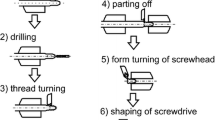Abstract
Magnesium alloys have been in the focus of research in recent years as degradable biomaterial. The purpose of this study was the biomechanical characterisation of MgCa0.8-screws. The maximum pull out force of screws was determined in a synthetic bone without corrosion and after fixed intervals of corrosion: 24, 48, 72 and 96 h. This in vitro study has been carried out with Hank’s solution with a flow rate corresponding to the blood flow in natural bone. A maximum pull out force (Fmax) of 201.5 ± 9.3 N was measured without corrosion. The biomechanical parameter decreased by 30% after 96 h in corrosive medium compared to the non-corrosion group. A maximum load capacity of 28 ± 7.6 N/h was determined. Our biomechanical data suggests that this biodegradable screw provides a promising bone-screw-fixation and has great potential for medical application.







Similar content being viewed by others
References
Disegi JA, Eschbach L. Stainless steel in bone surgery. Injury. 2000;31(Suppl 4):2–6.
Stiffler KS. Internal fracture fixation. Clin Tech Small Anim Pract. 2004;19:105–13.
Claes LE. Mechanical characterization of biodegradable implants. Clin Mater. 1992;10:41–6.
Taylor MS, Daniels AU, Andriano KP, Heller J. Six bioabsorbable polymers: in vitro acute toxicity of accumulated degradation products. J Appl Biomater. 1994;5:151–7.
Van der Elst M, Bramer JA, Klein CP, de Lange ES, Patka P, Haarman HJ. Biodegradable interlocking nails for fracture fixation. Clin Orthop Relat Res. 1998;357:192–204.
Witte F. The history of biodegradable magnesium implants: a review. Acta Biomater. 2010;6:1680–92.
Nagels J, Stokdijk M, Rozing PM. Stress shielding and bone resorption in shoulder arthroplasty. J Should Elbow Surg. 2003;12:35–9.
Witte F, Hort N, Vogt C, Cohen S, Kainer KU, Willumeit R, Feyerabend F. Degradable biomaterials based on magnesium corrosion. Curr Opin Solid State Mater Sci. 2008;12:63–72.
Li Z, Gu X, Lou S, Zheng Y. The development of binary Mg–Ca alloys for use as biodegradable materials within bone. Biomaterials. 2008;29:1329–44.
Janning C, Willbold E, Vogt C, Nellesen J, Meyer-Lindenberg A, Windhagen H, Thorey F, Witte F. Magnesium hydroxide temporarily enhancing osteoblast activity and decreasing the osteoclast number in peri-implant bone remodelling. Acta Biomater. 2010;6:1861–8.
Revell PA, Damien E, Zhang XS, Evans P, Howlett CR. The effect of magnesium ions on bone bonding to hydroxyapatite. Key Eng Mater. 2004;254–256:447–50.
Hartwig A. Role of magnesium in genomic stability. Mutat Res. 2001;475:113–21.
Witte F, Kaese V, Haferkamp H, Switzer E, Meyer-Lindenberg A, Wirth CJ, Windhagen H. In vivo corrosion of four magnesium alloys and the associated bone response. Biomaterials. 2005;26:3557–63.
Krause A, Von der Höh N, Bormann D, Krause C, Bach FW, Windhagen H, Meyer-Lindenberg A. Degradation behaviour and mechanical properties of magnesium implants in rabbit tibiae. J Mater Sci. 2010;45:624–32.
Kirkland NT, Birbilis N, Walker J, Woodfield T, Dias GJ, Staiger MP. In vitro dissolution of magnesium–calcium binary alloys: clarifying the unique role of calcium additions in bioresorbable magnesium implant alloys. J Biomed Mater Res B Appl Biomater. 2010;95:91–100.
Li Y, Hodgson PD, Wen C. The effects of calcium and yttrium additions on the microstructure, mechanical properties and biocompatibility of biodegradable magnesium alloys. J Mater Sci. 2011;46:365–71.
Lahtinen T, Karjalainen P, Alhava EM. Measurement of bone blood flow with a 133 Xe washout method. A preliminary report. Eur J Nucl Med. 1979;4:435–9.
Xin Y, Hu T, Chu PK. Influence of test solutions on in vitro studies of biomedical magnesium alloys. J Electrochem Soc. 2010;157:C238–43.
Zeng R, Dietzel W, Witte F, Hort N, Blawert C. Progress and challenge for magnesium alloys as biomaterials. Adv Eng Mater. 2008;10:B3–14.
Geetha M, Durgalakshmi D, Asokamani R. Biomedical implants: corrosion and its prevention—a review. Recent Pat Corros Sci. 2010;2:40–54.
Brown GA, McCarthy T, Bourgeault CA, Callahan DJ. Mechanical performance of standard and cannulated 4.0-mm cancellous bone screws. J Orthop Res. 2000;18:307–12.
Chapman JR, Harrington RM, Lee KM, Anderson PA, Tencer AF, Kowalski D. Factors affecting the pullout strength of cancellous bone screws. J Biomech Eng. 1996;118:391–8.
Huber WO, Reihsner R, Trieb K, Wanivenhaus AH, Beer R. In vitro comparison of biomechanical efficiency of three cannulated screws for arthrodesis of the hindfoot. Foot Ankle Int. 2008;29:225–30.
Song GL, Atrens A. Corrosion mechanisms of magnesium alloys. Adv Eng Mater. 1999;1:11–33.
Leung MT, Rabie AB, Wong RW. Stability of connected mini-implants and miniplates for skeletal anchorage in orthodontics. Eur J Orthod. 2008;30:483–9.
Loukota RA, Shelton JC. Mechanical analysis of maxillofacial miniplates. Br J Oral Maxillofac Surg. 1995;33:174–9.
Erdmann N, Angrisani N, Reifenrath J, Lucas A, Thorey F, Bormann D, Meyer-Lindenberg A. Biomechanical testing and degradation analysis of MgCa0.8 alloy screws: a comparative in vivo study in rabbits. Acta Biomater. 2011;7:1421–8.
Florvaag B, Kneuertz P, Lazar F, Koebke J, Zöller JE, Braumann B, Mischkowski RA. Biomechanical properties of orthodontic miniscrews. An in vitro study. J Orofac Orthop. 2010;71:53–67.
Song G, Atrens A. Understanding magnesium corrosion—a framework for improved alloy performance. Adv Eng Mater. 2003;5:837–58.
Acknowledgements
The authors gratefully acknowledge the financial support given by German Research Society (DFG) within the collaborative research project (SFB 599).We thank Markus Badenhop for excellent technical support.
Author information
Authors and Affiliations
Corresponding author
Rights and permissions
About this article
Cite this article
Waizy, H., Weizbauer, A., Maibaum, M. et al. Biomechanical characterisation of a degradable magnesium-based (MgCa0.8) screw. J Mater Sci: Mater Med 23, 649–655 (2012). https://doi.org/10.1007/s10856-011-4544-8
Received:
Accepted:
Published:
Issue Date:
DOI: https://doi.org/10.1007/s10856-011-4544-8




